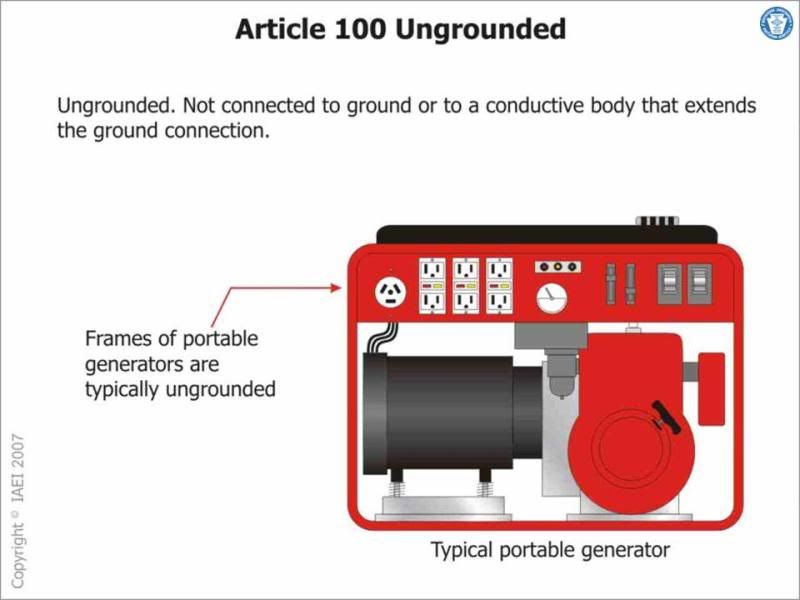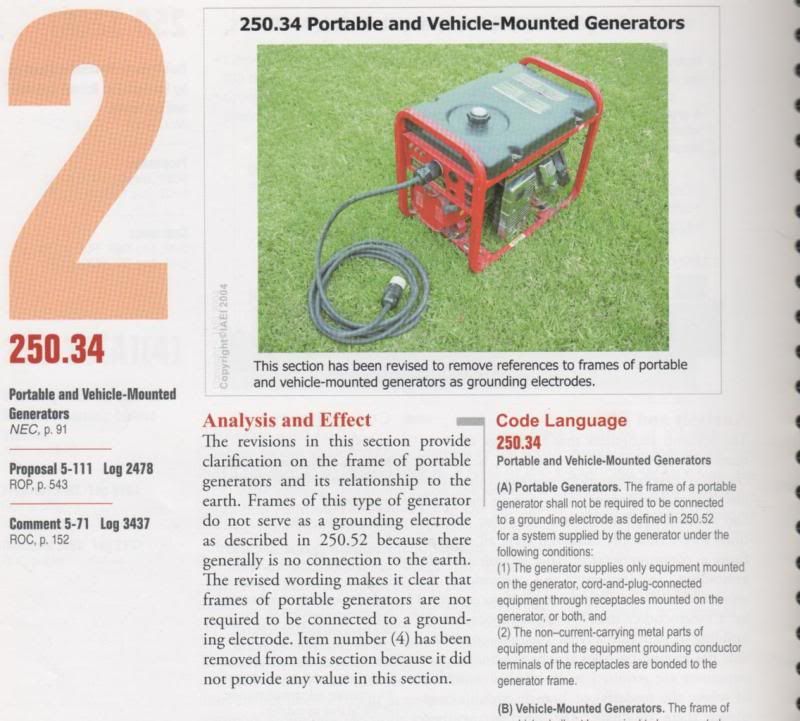I made a post that once that a generator becomes attached to premises wiring that the generator is no longer portable (post #9) and you and Bob came back with a comment looking for proof of my statement.
I know that Bob is pretty smart so I figured by the way he asked the question (post #19) he already knew the definition of premises wiring so I took a different approach as I many time do just for fun and thus all this with you has transpired.
Any generator that is connected to the premises wiring system becomes part of that system as outlined in the definition of premises wiring. So any time any generator becomes connected to the building it is no longer portable or should I say is no more portable than what ever it is connected to is portable.
Well, I read your words and understand your perspective... but I respectfully disagree.
Put a portable generator on a property that has no other source of electrical power and by the definition of a premises wiring (system) in Article 100, that PG is a premises wiring system. The NEC even dedicates Article 445 to the installation of generators. We've even been discussing a specific section on their grounding. Now one might ask: how do I install a portable generator? ...Well you simply plop it down wherever convenient and start it up.

As anyone who knows me will tell you and Scott has pointed out I will continue something like this until we have covered the entire code book before relenting.
I surmised such. Knock yourself out... but don't expect me to get all wordy in reply.

The answer to the portable generator being used as an optional stand by system is found in Part III of 702 and nobody mentioned this in this complete thread. Is this because they didn?t know or was too wrapped up in my sick sense of humor?
And look at the Scope therein...
702.1 Scope. The provisions of this article apply to the
installation and operation of optional standby systems.
The systems covered by this article consist of those that
are permanently installed in their entirety, including prime
movers, and those that are arranged for a connection to a
premises wiring system from a portable alternate power
supply.
So even here we have a statement which supports the concept that portable source remains portable even while connected.
But your statement that 250.34 requires a portable generator to be connected to earth is way off base.
(code citation removed by me for brevity)
It's not hard to understand. 250.34(C) says when connected to a system conductor required to be grounded, the frame must be bonded to the grounded conductor. If the mentioned grounded conductor is grounded as required, then how can the generator not be grounded?
Here is a slide from the 2008 Analysis of changes
...
Notice that this portable generator is an ungrounded system. This means that is has no earth connection.
I agree. As pictured it is not grounded.
Here is part of page 90 of the 2008 Analysis of changes that clears up any confusion about a portable generator and an earth connection.
Well, the analysis doesn't clear up anything for me... as there is nothing to clear up from my perspective.
There is no requirement to connect a portable generator to earth UNLESS someone decides to use this as an optional standby system.
I agree.
The new requirement found in 590 that all receptacles under 14kw are to be GFCI protect will insure that when this portable generator is connected as an optional standby system the neutral will be switched or the GFCI device will open. Or in other words this Ungrounded Portable Generator can no longer be connected to a premises wiring system as a Non-Separately Derived System.
Have to disagree. You are assuming the frame to grounded conductor connection required by 250.34(C) is not removed. What would trip the GFCI's (other than a real ground fault) would be some of the ungrounded conductor current not returning on the grounded neutral conductor... because instead it returns on the grounding conductors, for they are essentially a parallel path. As such, the frame to grounded neutral conductor connection can be eliminated under 250.6(A) and (B) for a non-SDS connection.
There is also a new section 250.30(C) that covers the grounding when installing this Ungrounded Portable Generator to premises wiring.
...and 250.30 covers SDS's. Show me code that actually says a PG cannot be connected non-SDS.
To answer your question concerning ARTICLE 225 Outside Branch Circuits and Feeders, the conductors from that generator and the premises wiring are just as outlined in the title of this article, they are outside making this article prudent to the installation especially Part II.
Oh I know the Article is pertinent to installation, but thanks for the reminder




